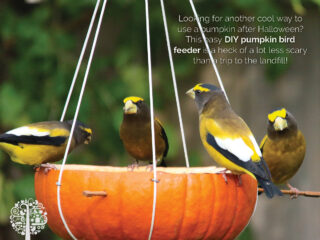When Halloween is over, don’t toss your pumpkins and gourds into the trash. Instead, turn them into bird feeders. This easy DIY project gives a jack-o’-lantern a second life and provides the birds with a Halloween treat, too.

How To Make a Pumpkin Feeder
If you haven’t carved your pumpkin or gourd, start by cutting it in half and scooping out the seeds. Both the top and bottom halves can be used as feeders, provided the walls of the hollowed-out interior are at least 0.5 inches thick, which gives the feeder extra strength when hung.
If your pumpkin is already carved, cut around the circumference of the design to create a wide opening for birds to access the interior where the seeds will be. If you used a candle to light the pumpkin, remove any wax and charred areas on the inside walls. The removable top of the pumpkin makes an excellent roof for the feeder, keeping birds dry and sheltered while they snack.
Whether the feeder is covered or uncovered, drill three or four small holes in the bottom of the pumpkin for drainage. Make sure the holes are smaller than the seeds you plan to use, or they will spill out of the feeder. Next, make holes in the sides of the pumpkin between the bottom and middle, and insert sticks or twigs for the birds to perch on.
Where to Place the Pumpkin Feeder
It’s fun to watch the birds snack, but they prefer privacy – so finding a spot in the garden or on a patio that is visible but also away from human activity is ideal.
Drill two holes near the top of the feeder on opposite sides of each other. If the pumpkin is heavy, repeat the process on all four sides. Cut pieces of heavy twine or rope, about two feet long, and thread them through the holes you just made, securing them with a double knot wider than the hole on the inside of the feeder. To hang the feeder, knot the rope ends together and hang it from a low tree branch, shrub, or even a hook under the eaves.
Adding Seeds to a Pumpkin Feeder
Fill the bottom of the feeder with a generous layer of birdseed. Over time, the birds will not only enjoy the seeds but will also pick away at the inside walls of the pumpkin.
Decomposing Pumpkin Feeders and Critters
As time passes, the feeder will start to decompose, and small pieces will break off and fall to the ground. If hung over a garden bed, the pumpkin will add nutrients to the soil. If the feeder is over a patio, remember to sweep up these bits and add them to the compost. They can attract other critters, such as raccoons, squirrels, and mice, who may also decide to help themselves to a snack and raid the feeder. If you’re concerned about rodents, take the feeder down at night and store it in a cool, dry place such as a garage. Just remember to put it back up in the morning.